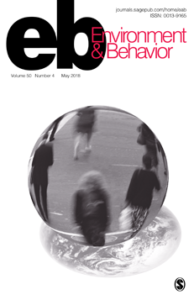Earth Day: Research for a Better World
April is a good time to explore SAGE journals you may not have had a chance to read. Log in here to browse and download articles. (See this related post for search and navigation tips on the journal hub.)
 Celebrate Earth Day by renewing your interest in global climate issues and their social, cultural, political, and economic implications! You can find SAGE journals with an environmental focus, and articles on related topics throughout the collection. Use the open access credentials link above to find publications and studies that relate to your areas of interest. Here are a few suggestions to get you started:
Celebrate Earth Day by renewing your interest in global climate issues and their social, cultural, political, and economic implications! You can find SAGE journals with an environmental focus, and articles on related topics throughout the collection. Use the open access credentials link above to find publications and studies that relate to your areas of interest. Here are a few suggestions to get you started: Environment and Behavior (EAB) examines relationships between human behavior and the natural and built environment. Research topics include environmental experiences (e.g., restorativeness, place attachment/identity, environmental perception/cognition); environmental outcomes (e.g., pro-environmental behaviors such as recycling; health-supportive environments; design preferences); and processes linking environments and behaviors that support or thwart human well-being. A recent article: "Young People’s Coping Strategies Concerning Climate Change: Relations to Perceived Communication With Parents and Friends and Proenvironmental Behavior" by Maria Ojala, Hans Bengtsson.
Environment and Behavior (EAB) examines relationships between human behavior and the natural and built environment. Research topics include environmental experiences (e.g., restorativeness, place attachment/identity, environmental perception/cognition); environmental outcomes (e.g., pro-environmental behaviors such as recycling; health-supportive environments; design preferences); and processes linking environments and behaviors that support or thwart human well-being. A recent article: "Young People’s Coping Strategies Concerning Climate Change: Relations to Perceived Communication With Parents and Friends and Proenvironmental Behavior" by Maria Ojala, Hans Bengtsson. New Solutions (NEW) is a peer-reviewed journal that explores the growing, changing common ground at the intersection of health, work, and the environment. A new article: "Work and Female Breast Cancer: The State of the Evidence, 2002–2017" by Connie L. Engel, M. Sharima Rasanayagam, Janet M. Gray, andJeanne Rizzo.The Journal of Environment & Development (JED), seeks to
New Solutions (NEW) is a peer-reviewed journal that explores the growing, changing common ground at the intersection of health, work, and the environment. A new article: "Work and Female Breast Cancer: The State of the Evidence, 2002–2017" by Connie L. Engel, M. Sharima Rasanayagam, Janet M. Gray, andJeanne Rizzo.The Journal of Environment & Development (JED), seeks to  further research and debate on the nexus of environment and development issues at the local, national, regional, and international levels. JED provides a forum that bridges the parallel debates among policy makers, attorneys, academics, business people, and NGO activists worldwide. A current article: "Land-Use Planning, Digital Technologies, and Environmental Conservation in Tanzania" by Chris Huggins.
further research and debate on the nexus of environment and development issues at the local, national, regional, and international levels. JED provides a forum that bridges the parallel debates among policy makers, attorneys, academics, business people, and NGO activists worldwide. A current article: "Land-Use Planning, Digital Technologies, and Environmental Conservation in Tanzania" by Chris Huggins. Energy & Environment is an interdisciplinary journal inviting energy policy analysts, natural scientists and engineers, as well as lawyers and economists to contribute to mutual understanding and learning, believing that better communication between experts will enhance the quality of policy, advance social well-being and help to reduce conflict. The journal encourages dialogue between the social sciences as energy demand and supply are observed and analysed with reference to politics of policy-making and implementation. One of the most read articles: "What does the Paris Agreement actually do?" by David Campbell.
Energy & Environment is an interdisciplinary journal inviting energy policy analysts, natural scientists and engineers, as well as lawyers and economists to contribute to mutual understanding and learning, believing that better communication between experts will enhance the quality of policy, advance social well-being and help to reduce conflict. The journal encourages dialogue between the social sciences as energy demand and supply are observed and analysed with reference to politics of policy-making and implementation. One of the most read articles: "What does the Paris Agreement actually do?" by David Campbell. The Journal of Education for Sustainable Development (JESD) is a forum for academics and practitioners to share and critique innovations in thinking and practice in the emerging field of Education for Sustainable Development (ESD). A recent article: "Improving Sustainable Living Education through the Use of Formative Experiments" by Brooklynn Wynveen.Campbell, D. (2016). What does the Paris Agreement actually do? Energy & Environment, 27(8), 883-895. doi:10.1177/0958305X16675524Engel, C. L., Sharima Rasanayagam, M., Gray, J. M., & Rizzo, J. (2018). Work and female breast cancer: The state of the evidence, 2002–2017. NEW SOLUTIONS: A Journal of Environmental and Occupational Health Policy, 28(1), 55-78. doi:10.1177/1048291118758460Huggins, C. (2018). Land-use planning, digital technologies, and environmental conservation in Tanzania. The Journal of Environment & Development, 1070496518761994. doi:10.1177/1070496518761994Ojala, M., & Bengtsson, H. (2018). Young people’s coping strategies concerning climate change: Relations to perceived communication with parents and friends and proenvironmental behavior. Environment and Behavior, 0013916518763894. doi:10.1177/0013916518763894Wynveen, B. J. (2017). Improving sustainable living education through the use of formative experiments. Journal of Education for Sustainable Development, 11(1), 14-32. doi:10.1177/0973408217696532
The Journal of Education for Sustainable Development (JESD) is a forum for academics and practitioners to share and critique innovations in thinking and practice in the emerging field of Education for Sustainable Development (ESD). A recent article: "Improving Sustainable Living Education through the Use of Formative Experiments" by Brooklynn Wynveen.Campbell, D. (2016). What does the Paris Agreement actually do? Energy & Environment, 27(8), 883-895. doi:10.1177/0958305X16675524Engel, C. L., Sharima Rasanayagam, M., Gray, J. M., & Rizzo, J. (2018). Work and female breast cancer: The state of the evidence, 2002–2017. NEW SOLUTIONS: A Journal of Environmental and Occupational Health Policy, 28(1), 55-78. doi:10.1177/1048291118758460Huggins, C. (2018). Land-use planning, digital technologies, and environmental conservation in Tanzania. The Journal of Environment & Development, 1070496518761994. doi:10.1177/1070496518761994Ojala, M., & Bengtsson, H. (2018). Young people’s coping strategies concerning climate change: Relations to perceived communication with parents and friends and proenvironmental behavior. Environment and Behavior, 0013916518763894. doi:10.1177/0013916518763894Wynveen, B. J. (2017). Improving sustainable living education through the use of formative experiments. Journal of Education for Sustainable Development, 11(1), 14-32. doi:10.1177/0973408217696532
